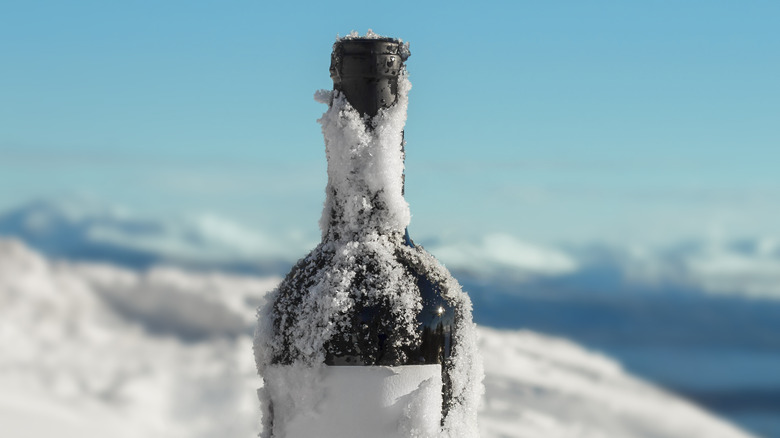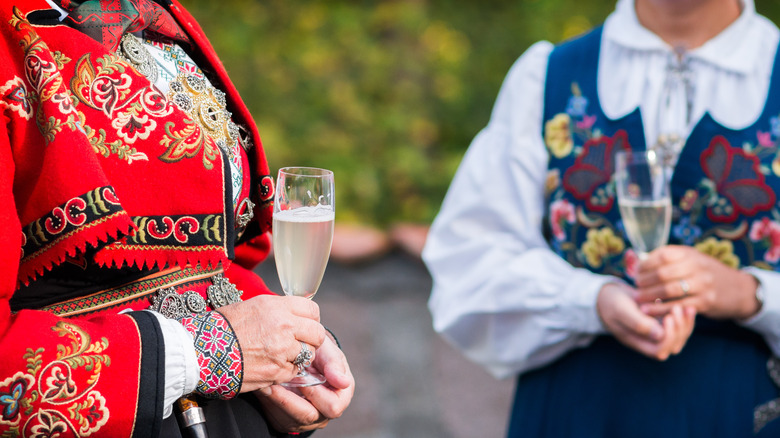2 Nordic Countries Are The Most Expensive In The World For Buying Wine
Even if you don't go for the most prized options out there, buying a bottle of wine can take a chunk out of your wallet — and it can also cost you even more depending on where you are when you buy it. For instance, according to the Wine Habit Index on Compare My Jet, the average price of a bottle of wine in the United States is about £12.33 (roughly $14.97), while Spain averages £4.89 ($5.94), and Portugal comes in at the lowest average price at £3.49 ($4.24).
But if you think that seems a little unfair (or maybe a good reason to move overseas), the U.S. doesn't have the highest average price for a bottle of wine. The two countries with that designation are actually closer to large wine-producing countries such as Italy, France, and Spain, which is why it may come as a surprise that their wine — and, in fact, any and all alcohol — is so much more expensive.
Iceland is the most expensive country to buy wine
Leading the world as the most expensive place to buy wine is Iceland, averaging £14.97 (about $18.17) per bottle. What's behind this steep price tag? Iceland is known to mark up its alcohol, and it's mostly thanks to taxes. In most Scandinavian countries, alcohol is taxed rather high; sometimes, up to 80% of the price of a bottle of spirits might be just from tax. With a markup like that, it's no wonder that people in Iceland tend to drink considerably less often than citizens of other European countries — most people can't afford to binge or overindulge in alcohol.
But the people of Iceland also prefer natural wines when they drink, which drives up the base price of the wine even before taxes. According to the Reykjavík Grapevine, natural wine is made from organically grown grapes that are fermented without additives. Making these wines is more expensive than non-organic wines because the wine growers must pay to be certified and use natural products and materials, which are often more expensive. Additionally, the vineyards typically produce lower yields — and though there are a few wineries in Iceland, those organic grapes must be imported. It's simply too cold for Iceland to grow its own.
Given the demand for natural wines and the additional tax, it is no wonder a bottle in Iceland is so expensive. But one of its Nordic neighbors isn't far behind that high average price tag.
Norway's regulations make its wine nearly as expensive as Iceland's
Norway has a bit better luck than Iceland when it comes to growing its own wine grapes. In fact, thanks to the effects of global warming, Norway now boasts the most Northern grown vineyard in the world, located between the 58th and 62nd parallels, called Skudenest Gaard estate. So the country does have its own source of wine — there's even a Norwegian Winegrowers Association. However, a heavy tax is still applied to alcoholic beverages regardless of whether they are made domestically or elsewhere. Drinks are taxed by alcohol by volume (ABV) percentage, and wine falls between 4.7% – 22% ABV. Those taxes come out to about 5.11 Norwegian krone ($0.51 USD) per ABV percent and liters, making it expensive but still less expensive than in Iceland — the Wine Habit Index sets Norway's average bottle price at £14.35 ($17.42).
But taxes aren't the only regulations driving up prices. According to Wine Business International, Norway's government-owned monopoly, Vinmonopolet, runs as provided under the 1989 Alcohol Act in Norway, which actively restricts the consumption of alcohol by its citizens. There is no long-standing wine scene or tradition of centuries-old, family-owned vineyards in Norway, so its society doesn't have the same cultural connection to wine that countries like France or Spain do. Rather, all wine (outside of ordering a glass at restaurants) must be purchased through government-run stores, and until fairly recently, it was not common in the country for people to drink alcohol during the week. Given these considerations, wine in Norway is not only expensive but can also be difficult to obtain.


